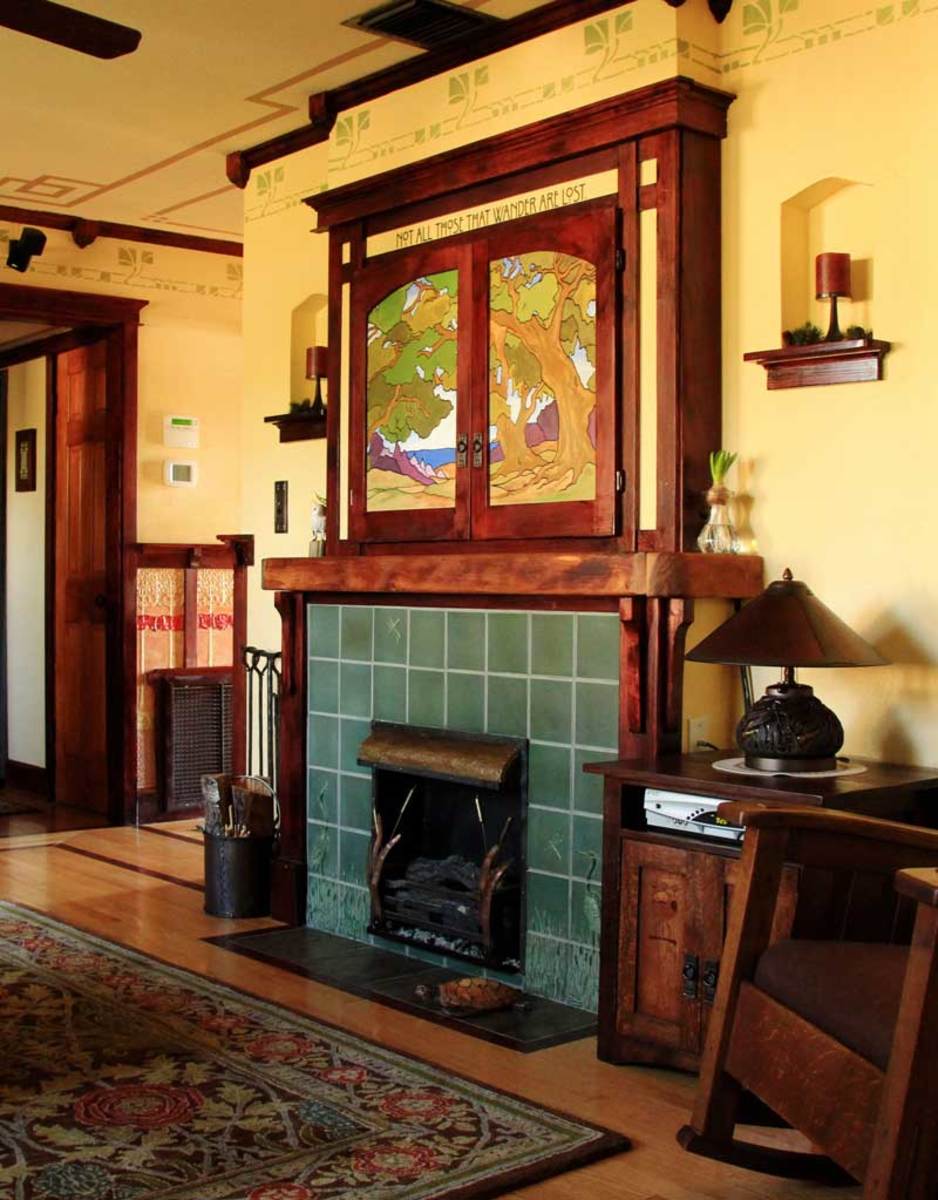Table Of Content

These ideas brought enthusiasm for arts and crafts, including a new interest in ceramics, textiles, metalwork, and furniture. A well-placed window box or an authentic period porch light can provide a focal point that sets the tone for a Craftsman-style home. Garage doors can also enhance the classic Craftsman styling, as seen with this charming exterior. Recessed panels in the garage doors mimic those in the front door, calling attention to the home's entry and lending a welcoming overall look.
"Tiny homes are not the big solution to homelessness that we need"
As the name suggests, Craftsman-style homes are often celebrated for the workmanship that goes into their design and construction. Historically built using locally sourced materials, the exteriors frequently feature decorative elements such as exposed beams, prominent columns, and stone accents. Inside, you'll often find custom details, including built-in shelving, impressive fireplaces, and thick wood trim around doors and windows. Arts and Crafts style homes date back to the mid-19th century, as a response to the perceived decline in the standard of homes in Britain during this era.
of the Best Home Decor Shops in Los Angeles, According to Top Designers
Teak, maple, oak, Port Orford cedar, and mahogany surfaces are placed in sequences to bring out contrasts of color, tone, and grain. Inlay in the custom furniture designed by the architects coordinates with the inlay in the tiled fireplace surrounds, and the expressed, interlocking joinery on the main staircase was left exposed. Wright himself would have a significant impact on the Craftsman movement not by designing homes for the lower classes, but by making Prairie Style and Chicago School houses for the comparatively wealthy. Others would commercialize and commoditize these forms, as seen in the Sears catalog's Craftsman-style mail-order bungalows (via Antique Home Style). “These homes will cost a premium—however, to me, it is more than worth it,” Smith says.
Arts and Crafts-style Arlington, Va., house for sale at $2.15 million - The Washington Post
Arts and Crafts-style Arlington, Va., house for sale at $2.15 million.
Posted: Fri, 30 Jun 2023 07:00:00 GMT [source]
Dezeen Magazine
On the first floor, an Arts and Crafts-style home will have an open living room that connects to a dining or multi-use space, with a small kitchen toward the rear of the house. The main living area will feature a fireplace, and if the home has a second story, there will likely be another fireplace in the largest bedroom. Ceilings were kept low to help conserve heat, which adds to the snug, cozy feel of these houses.
Wright also often incorporated windows into walls at their corners, thereby softening the impression of an indoor box occupied by the inhabitants. When it comes to the living space interior design of a Craftsman home, functionality is as important as the handcrafted touches. Yeley notes that elements like stained wood window trim, glass-paneled doors, ample shelves, and built-in storage details all add to the architecture. American bungalow-style homes were designed to be easy to build, which made them affordable for early-20th century working families.

This Craftsman house was given a fresh coat of olive paint with white and cranberry trim. The contrasting trim accents the horizontal lines of the traditional bungalow while helping the house stand out from the surrounding greenery. Edward Bok, editor of The Ladies’ Home Journal, the era’s largest and most influential women’s magazine, quickly picked up the Arts & Crafts banner. In 1895, the Journal initiated a long-running series of Arts & Crafts-influenced house designs by noted architects, including William L. Price, E. G. W. Dietrich, and Frank Lloyd Wright.
California Historical Landmark Marker
It was an exciting spectacle, but it did have its detractors, including William Morris, one of the movement’s most famous figures. He was so appalled by the show’s excesses that it reputedly reduced him to a bout of sickness. Craftsman-style homes are generally considered a reaction against Victorian-style architecture's eclectic, ornate look. This simplified aesthetic features horizontal lines, low-pitched gable roofs, and spacious covered front porches. Craftsman-style homes have devoted fans who love their unique and instantly recognizable facade and interior details, including warm wood tones and classic floorplans. Popularized during the Arts and Crafts movement of the late 1800s, this hardworking architectural style is found frequently in small, economical bungalows.
Arts and Crafts Architecture: Design Style and Origins
‘George Walton, who was a friend of Mackintosh, is very under-rated, perhaps because his designs are rather subtle,’ says Paul. The upper level of this Craftsman home is an addition that blends seamlessly into the original 1911 bungalow design. Exposed rafter tails stick out from under the eaves, adding interest to the roofline and tying the new addition in with the rest of the home.
Historic details in Berkeley, California
This style of porch column is usually wider at the base than at the top and might feature carved details, as seen on this Craftsman bungalow. The design reinforces the traditional look of the exterior while offering sturdy support for the roof. The biggest promoter of the American Arts & Crafts movement, however, was an erstwhile furniture-maker named Gustav Stickley. From 1900 until 1916, Stickley’s hugely popular magazine, The Craftsman, encouraged readers to build, furnish, and decorate their own homes using Arts & Crafts principles. Simple furnishings from the Stickley factories were featured in the magazine’s pages, which also provided free designs for Craftsman houses.
"Craftsman" was appropriated from furniture-maker Gustav Stickley, whose magazine The Craftsman was first published in 1901. The architectural style was most widely used in small-to-medium-sized Southern California single-family homes from about 1905, so the smaller-scale Craftsman style became known alternatively as "California bungalow". The style remained popular into the 1930s and has continued with revival and restoration projects. Wood shingles, stonework, and stucco siding are often featured prominently on Craftsman facades. Learn more about the signature exterior details of Craftsman-style homes in this video. Play up Craftsman style with exterior paint colors that reflect shades seen in fields and forest.

From the exterior, potential buyers can likely spot columns supporting a front porch and chimney protruding from the roof. Through symmetrical windows, interiors often reveal wood-clad rooms decorated in a traditional style with several smaller rooms avoiding open floor plans. These homes have a wide and low design with natural exteriors of wood, stone, brick, and stucco. The prairie home style ended around WWI, with its elements morphing into modern styles like ranches and mid-century modern. Exterior renovations to this Craftsman-style home focused on playing up the Arts and Crafts aesthetic, which favors clean lines and natural materials. The restored front door features a hand-hewn feel and looks out on a concrete porch, which was given new cut marks to suggest stone-block construction.
Americans, however, readily took to newly improved, fireproof concrete building products. Henry Chapman Mercer’s famous Moravian Pottery and Tile Works factory in Doylestown, Pennsylvania, which specialized in glazed tiles in medieval patterns, was constructed entirely of concrete, as was Fonthill, Mercer’s castle-like home nearby. The living room was designed without any entry doors so that the room would be as open and inviting as possible. It also consisted of a spacious sitting room, which was decorated with five rugs that were designed by Charles Greene using watercolor. Across from the fireplace, there is a window that leads to the terrace, which overlooks the garden.
Americans also sought a simpler but aesthetically richer life, and they were enthusiastic about their own diverse architectural heritage. On the contrary, they believed factories were as capable as individual craftsmen of producing quality design—and at a much lower cost, making it available to more people. Exterior porches are found off three of the second-floor bedrooms and were used for sleeping or entertaining.
Interestingly, the Arts and Crafts style toned down the intricate ornamentation of the Victorian era, and it helped lead to open floor plans in living spaces. Though Arts and Crafts design became less popular after World War I, the ideals behind the movement (well-made, handcrafted design) remained important throughout history. You'll still find examples of Arts and Crafts-style homes and the cozy Bungalow or the Craftsman home. Again, in an effort to reject the design periods that came before, Arts and Crafts homes were made from natural elements. The use of local materials was encouraged, and you will often see the use of real stone, brick, and wood throughout the home. These Arts and Crafts houses have a small square footage, which feels larger because of the open floor plans.
However, when you buy something through our retail links, we may earn an affiliate commission. Better lines, better proportions, better trim—and an Arts & Crafts house rises in the neighborhood. One of the wooden panels in the entry hall is actually a concealed door leading to the kitchen, and another panel opens to a coat closet. This home style's beautifully simple, functional, rustic, and hand-hewn look appeals to many. You'll also find fine handiwork features throughout the home, such as hammered metalwork and the use of authentic copper and bronze. Designers and craftsmen took pride in their work, and so an Arts and Crafts home will often feel well-made and thoughtful.
Ever Heard of “Arts and Crafts Revival?” Neither Had We Until We Toured This House - ELLE Decor
Ever Heard of “Arts and Crafts Revival?” Neither Had We Until We Toured This House.
Posted: Mon, 08 Jan 2024 08:00:00 GMT [source]
The Arts and Crafts movement was directly tied to the rise of Craftsman and Bungalow-style homes, architecture that played off of the same mentality of simple but thoughtful structures. Bungalows were intended to give working-class families the ability to own a well-designed home that was easy to maintain and manage. Arts and Crafts-style homes may be one of the most complex styles of architecture. While there are many key features of an Arts and Crafts home, the style draws similarities from several other architectural aesthetics, making it a little more difficult to pick it out. You'll find that Arts and Crafts isn't exactly a single style, but rather a specific approach to many different types of architecture.


No comments:
Post a Comment